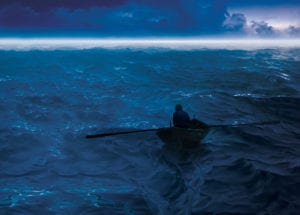By Daniel de la Calle
I am in Paris now, just for a couple weeks, and my visit has coincided with a fantastic documentary film festival called Pariscience. From medicine to biology, botany to meteorology, computer or space science, the selection encompasses an impressively broad range of fields of study and research. For example, yesterday I attended the screening of “How Heavy Is A Cloud?”, where I was surrounded by a couple hundred giggly schoolchildren and their shepherding teachers. The q&a, what I understood of it anyway, was absolutely endearing and revolved again and again and again around the unfathomable question: “if a cloud is so heavy, how can it be suspended in the air?” I felt the same way, hard to wrap my head around that one.
The day before I went to four or five screenings. One was about the always disturbing subject of plastic in the oceans. Here is an interesting figure that I noted down: France alone exports over 700,000 tons of recyclable plastics every year. From an ecological, from a moral standpoint this is simply unacceptable; the exports of trash and recyclables should be banned worldwide. Each country should deal with their own waste and have proper processing plants, instead of shipping it across the world to third world facilities. That is just out of sight, out of mind.
Another good documentary was a Franco-Canadian production on The Mystery of the Disappearance of Bees that has farmers and scientists in the U.S. (and little by little worldwide) so worried and puzzled. Of course it talked at length about the vital role bees play in modern day monocultural farming and plant pollination in general, and about the codependency amongst plants, insects and animals in nature. In fact, the term “coevolution” floated around several of the selected films. Most times I find it to be kind of redundant, since evolution is either due to coevolution or adaptation to the present environment. A film titled Amazing Plants showed some unbelievable and eye catching examples of coevolution, like the acacia ant and the swollen thorn acacia. Check out these great macro shots.
Finally, in this portrait of the planet as a perfect and ever-changing puzzle of correlation, cause and effect and intertwined dependence for survival, another documentary on meteorology outlined how satellite observation and counting of lightning strikes has brought to light that hurricanes hitting the Caribbean come two weeks after strong electric storms in certain parts of Africa, opening the door to forecasting these destructive natural catastrophes. One of the stories I like repeating the most to my friends (I hope I have not mentioned it here yet) is how the Sahara desert storms are fertilized by over 40 million tons of sand from the Amazon jungle every year. Science can be so poetic.
In case I left you curious and wondering, the weight of the water in a smallish cumulus is a bit less than 600 tons. If I did not understand it wrong (pardon my French), the water content in a cloud only adds up to 1% of its total weight. Finally, next time you see a storm coming (there are around 2,000 rain storms taking place at any given moment on planet Earth), keep in mind that a large cumulonimbus can hold up to 1 billion tons of water.
Cloudy September sunset from my terrace.



